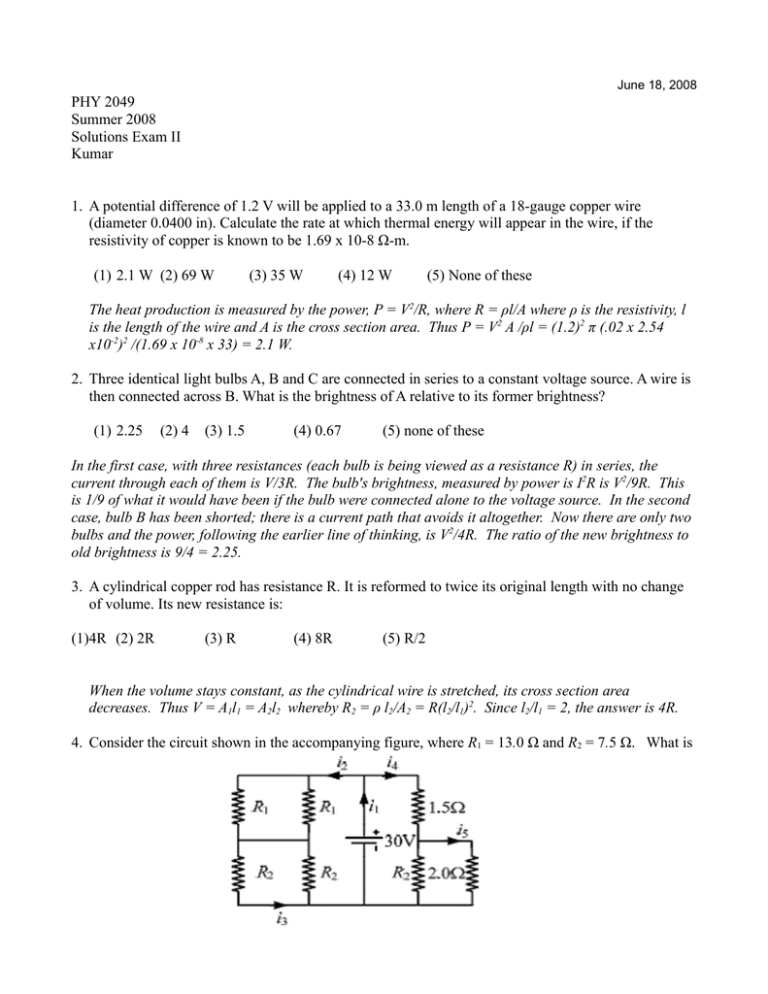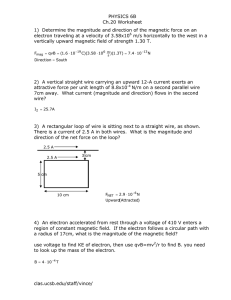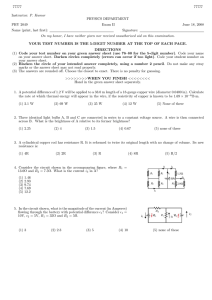PHY 2049 Summer 2008 Solutions Exam II Kumar
advertisement

June 18, 2008 PHY 2049 Summer 2008 Solutions Exam II Kumar 1. A potential difference of 1.2 V will be applied to a 33.0 m length of a 18-gauge copper wire (diameter 0.0400 in). Calculate the rate at which thermal energy will appear in the wire, if the resistivity of copper is known to be 1.69 x 10-8 Ω-m. (1) 2.1 W (2) 69 W (3) 35 W (4) 12 W (5) None of these The heat production is measured by the power, P = V2/R, where R = ρl/A where ρ is the resistivity, l is the length of the wire and A is the cross section area. Thus P = V2 A /ρl = (1.2)2 π (.02 x 2.54 x10-2)2 /(1.69 x 10-8 x 33) = 2.1 W. 2. Three identical light bulbs A, B and C are connected in series to a constant voltage source. A wire is then connected across B. What is the brightness of A relative to its former brightness? (1) 2.25 (2) 4 (3) 1.5 (4) 0.67 (5) none of these In the first case, with three resistances (each bulb is being viewed as a resistance R) in series, the current through each of them is V/3R. The bulb's brightness, measured by power is I2R is V2/9R. This is 1/9 of what it would have been if the bulb were connected alone to the voltage source. In the second case, bulb B has been shorted; there is a current path that avoids it altogether. Now there are only two bulbs and the power, following the earlier line of thinking, is V2/4R. The ratio of the new brightness to old brightness is 9/4 = 2.25. 3. A cylindrical copper rod has resistance R. It is reformed to twice its original length with no change of volume. Its new resistance is: (1)4R (2) 2R (3) R (4) 8R (5) R/2 When the volume stays constant, as the cylindrical wire is stretched, its cross section area decreases. Thus V = A1l1 = A2l2 whereby R2 = ρ l2/A2 = R(l2/l1)2. Since l2/l1 = 2, the answer is 4R. 4. Consider the circuit shown in the accompanying figure, where R1 = 13.0 Ω and R2 = 7.5 Ω. What is the current i3 in A? (1) 1.46 (2) 2.93 (3) 9.74 (4) 7.69 (5) 12.2 The part of the circuit on left is parallel to the part on right. It is therefore subject to the full 30V potential difference. The equivalent resistance on the left is (R1+R2)/2 = 10.125 Ω. The current through this part of the circuit is therefore V/R = 30/10.125. But the current i3 is only half of it. Looking backwards, the two branches are equivalent and therefore i3 = 15/10.125 = 1.46A. 5. In the circuit shown, what is the magnitude of the current (in Amperes) flowing through the battery with potential difference E1? Consider E1 = 10V, E2 = 5V, R1 = 35 Ω and R2 = 5 Ω. (1) 3 (2) 2.3 (3) 5 (4) 10 (5) none of these. The outside loop traversed counterclockwise leads to E2 -I1R2 +E1 = 0. It follows that I1 = (E1+E2)/R2 = 3A. The answer does not depend on R1. Just for curiosity, you might ask what are i2 and i3? Take the right loop counterclockwise, E2 +i3R1 = 0. We get i3 = -5/35 = -0.143A. The junction rule says that i1 = i2+i3 or i2 = i1 – i3 = 3 + 0.143 = 3.143 A. The minus sign in the answer means that the current i3 goes from top to bottom. 6. Five 4.00 Ω resistors have been arranged in the figure. Find the equivalent resistance (in Ω) between points F and G. (1) 2.5 (2) 6.25 (3) 2.0 (4) 3.125 (5) none of these Imagine a battery connected across the ends F and G. In terms of unknown resistances R, the two on top are in series equal to 2R. That is parallel to an R for an equivalent resistance of 2R/3. That is in series with an R making up 5R/3, which is now parallel to another R, for an equivalent resistance of 5R/8. With R = 4, the answer is 2.5 Ω. The equivalent resistance between F and H is R/2. 7. In a uniform magnetic field, an electron undergoes a circular motion with a kinetic energy of 6.4 x 10-17 J. The radius of the orbit is 5.0 mm. What is the magnetic field in T? (1) 1.35 x 10-2 (2) 3.20 x 10-4 (3) 1.28 x 10-7 (4) 3.52 x 10-5 (5) 2.96 x 10-3 The Radius of a cyclotron (which is what an electron orbiting around in a magnetic field is called) orbit is R = p/eB. In terms of energy K, the momentum p = √(2mK). Thus B = √(2mK) /eR = √(2x9.11x10-31x 6.4x10-17) /(1.6x10-19x5x10-3) = .0135 T 8. At one instant an electron (charge = -1.6 x 10-19 C) is moving in the xy plane, the components of its velocity being vx = 5 x105 m/s and vy = 3 x 105m/s. A magnetic field of 0.8 T is in the positive x direction. At that instant the magnitude of the magnetic force on the electron is: (1) 3.8 x 10-14 N (2) 2.6 x 10-14 N (3) 0 (4) 6.4 x 10-14 N (5) 1.0 x 10-13 N The magnetic force is F = q v x B = qvyBx = 3.8 x 10-14 N 9. A loop of wire carrying a current of 2.0 A is in the shape of a right triangle with two equal sides, each 15 cm long. A 0.7 T uniform magnetic ¯eld is in the plane of the triangle and is perpendicular to the hypotenuse. The magnetic force on either of the two equal sides has a magnitude of: (1) 0.15 N (2) 0.105 N (3) 0 (4) 0.21 N (5) 0.25 N F = l I x B = .15x 2 x 0.7 x sin45 = 0.15 N 10. Two long straight wires pierce the plane of the paper at vertices of an equilateral triangle as shown. They each carry 3A but in the opposite direction. The wire on the left has the current coming out of the paper while the wire on the right carries the current going into the paper. The magnetic field at the third vertex (P) has the magnitude and direction (North is up): (1) 15 μT, north (2) 17 μT, west (3) 20 μT, east (4) 26 μT, south (5) none of these The magnetic field at the third vertex is perpendicular to the line joining the point with the wire. Its x components cancel, the y components add to give. By = (μo/2π) (I/d) 2 sin30 = 15 μT. 11. In the figure, a long straight wire carries a current i1 = 39.7 A and a rectangular loop carries current i2 = 25.1 A. Take a = 1.19 cm, b = 9.23 cm, and L = 35:0 cm. What is the magnitude of the net force on the wire due to the loop? (1) 0.005 N (2) 0.001 N (3) 0.012 N (4) 0.02 N (5) none of these The question here asks to calculate the force on the upper wire carrying the current i1. But then plugging into a formula is difficult since the current forces typically involve a length and this wire is infinitely long. Newton comes to rescue in the form of his third law. The force on the wire due to the loop must be equal and opposite to the force on the loop due to the wire. Let's calculate the latter. The forces on the side branches are hard to calculate since the magnetic field due to the wire changes over the length of the arm. It needs integration, which can be done. But note that the force on the left side branch is equal and opposite to the one on the right branch (current changes direction). They cancel and there is no contribution to the net force. The force on the top branch is attractive (directed upwards) and stronger than the force on the bottom branch which is also repulsive (directed downwards) since the current direction is different. Therefore, the net force on the loop due to the wire is directed up and has a magnitude: F = L i2 (μo/2π)i1[1/a – 1/(a+b)] = 0.005 N The force on the wire is directed downwards and has the same magnitude.






